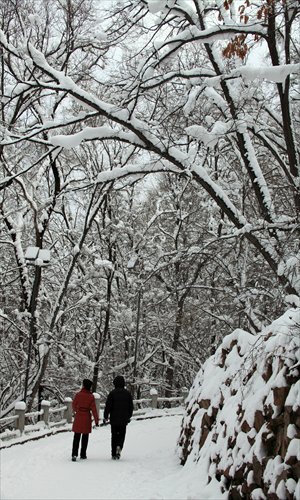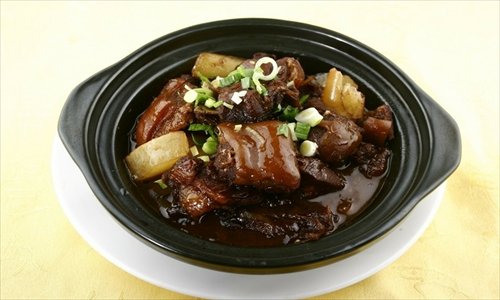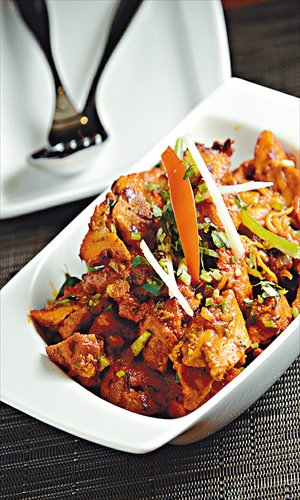The winter of our content
Editor's note
The ancient Chinese created an agricultural solar system - still in use today - that is based upon their observation of crops, climate, astrology, and the study of animal and plant life cycles. The system guided farmers as to when to sow seeds and when to harvest them, and this system has now been in place for more than 2,000 years.
Today, with advances in science and technology, agriculture depends less on this ancient wisdom. But this seasonal calendar still operates as a reference guide for gourmands to seek out the best times for seasonal delicacies and for health experts to plan nutritious diets.
In a single year, the system features 24 "solar terms," each lasting one day and occurring every two weeks. Each has its own name and characteristics. The Global Times is presenting a weekly series examining which foods and delicacies are best enjoyed during these periods, as well as tips on preserving general health.

This year, xiaoxue, (which means "light snow" in English) falls on November 22. And this particular period of the Chinese solar calendar coincides with Thanksgiving Day in the US.
As the name suggests, xiaoxue indicates the falling of snow, which is more likely in northern parts of China; snow very rarely falls so early in Shanghai and other parts of southern China.
Despite the abundant snowfall in some parts of the country, the weather remains generally dry. This was traditionally the time that families made preserved salty meats that were kept to be enjoyed at banquets during Spring Festival. And in southern China, xiaoxue is often marked by the eating of ciba, a glutinous rice cake which used to be offered as a sacrifice to gods in ancient times.
"Although it sounds obvious, keeping the body warm and preserving yang, a vital energy for warmth, is still the most important thing to keeping healthy at this time of year," Xiong Yizhe, a traditional Chinese medicine (TCM) practitioner at Shanghai Shuguang Hospital affiliated to the Shanghai University of Traditional Chinese Medicine, told the Global Times.
The Global Times has uncovered some recipes that have the ability to boost health, and which are easy to prepare at home.

Braised mutton with turnip
"Mutton helps to store energy as it contains high-quality protein, and it belongs to the category of food that is 'warm' in nature," Xiong said.
However, eating too much "warm" food will lead to excessive internal heat, and so it is advisable to eat some "cold" foods at the same time, such as turnip. Adding turnip and red dates to this recipe not only helps to remove the bad smell of mutton, but also facilitates the blood circulation.
Ingredients: 500 grams mutton, one turnip, a dozen soaked red dates, two pieces of ginger, three sprigs of spring onion cut into short sections, two star anises, two tablespoons of cooking oil, two tablespoons of Chinese rice wine, two tablespoons light soy sauce, one tablespoon dark soy sauce, two to three teaspoons sugar, a pinch of finely chopped garlic leaves, salt to taste.
Method:
Rinse and cut the mutton into pieces
Cut the turnip into small cubes
Heat up oil in a wok
When the oil is hot, add the spring onion, star anises, ginger, and quickly stir-fry
Put in the mutton and stir-fry until it turns light brown
Add in the soy sauce, Chinese rice wine, 200 milliliters of water or less, together with the red dates and bring to the boil
Turn down the heat and simmer for 20 minutes, and then add the turnip
Simmer until the mutton becomes tender and turnip is soft; add salt and sugar to taste
Before serving, sprinkle some garlic leaves on to add color and fragrance
Serve hot with a bowl of rice

Stewed chicken with dried orange peel
Chenpi, or dried orange peel, is used in TCM to aid the body's digestive and respiratory functions, according to Xiong. It is also widely used in Chinese soups.
Ingredients: four chicken legs chopped into pieces, four to five pieces of dried orange peel, two sprigs of spring onion, three pieces of ginger, two heads of garlic, two tablespoons of cooking oil, two tablespoons of Chinese rice wine, two tablespoons light soy sauce, sugar and salt to taste, several slices of fresh orange peel to garnish.
Method:
Rinse the chicken leg pieces
Heat up a wok and add cooking oil
Add the chicken pieces and stir-fry until they turn light brown
Add cooking oil to a clay pot, and then add the spring onion, garlic, ginger, and quickly stir-fry until aromatic
Put the stir-fried chicken pieces into the clay pot, and add water till it covers the pieces
Add the Chinese rice wine, dried orange peel, soy sauce, some salt and then boil
Turn down the heat and add sugar to taste
Simmer for 20 minutes, and turn up the heat to absorb the sauce
Decorate with fresh orange peel and serve hot